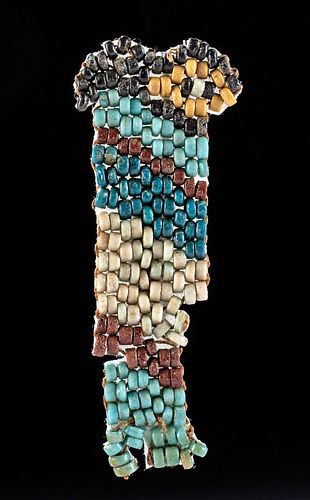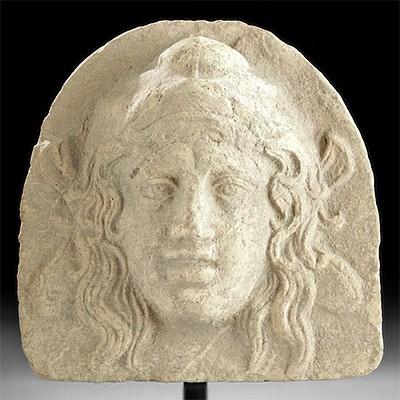Egyptian Nubian Faience Beaded Figure - Qebehsenuef
Lot 8b
About Seller
Artemis Fine Arts
686 S Taylor Ave, Ste 106
Louisville, CO 80027
United States
Selling antiquities, ancient and ethnographic art online since 1993, Artemis Gallery specializes in Classical Antiquities (Egyptian, Greek, Roman, Near Eastern), Asian, Pre-Columbian, African / Tribal / Oceanographic art. Our extensive inventory includes pottery, stone, metal, wood, glass and textil...Read more
Categories
Estimate:
$400 - $600
Absentee vs Live bid
Two ways to bid:
- Leave a max absentee bid and the platform will bid on your behalf up to your maximum bid during the live auction.
- Bid live during the auction and your bids will be submitted real-time to the auctioneer.
Bid Increments
| Price | Bid Increment |
|---|---|
| $0 | $25 |
| $300 | $50 |
| $1,000 | $100 |
| $2,000 | $250 |
| $5,000 | $500 |
| $10,000 | $1,000 |
| $20,000 | $2,500 |
| $50,000 | $5,000 |
| $100,000 | $10,000 |
| $200,000 | $20,000 |
About Auction
By Artemis Fine Arts
Feb 27, 2020
Set Reminder
2020-02-27 10:00:00
2020-02-27 10:00:00
America/New_York
Bidsquare
Bidsquare : VARIETY SALE | Antiquities & Ethnographic Art
https://www.bidsquare.com/auctions/artemis-gallery/variety-sale-antiquities-ethnographic-art-4920
Around the world & back in time - be amazed at the treasures you will find. Antiquities from Egypt, Greece, Italy and the Near East, Asian, Pre-Columbian, African / Tribal / Oceanic, Native American, Spanish Colonial, Russian Icons, Fine Art, much more! Artemis Fine Arts info@artemisgallery.com
Around the world & back in time - be amazed at the treasures you will find. Antiquities from Egypt, Greece, Italy and the Near East, Asian, Pre-Columbian, African / Tribal / Oceanic, Native American, Spanish Colonial, Russian Icons, Fine Art, much more! Artemis Fine Arts info@artemisgallery.com
- Lot Description
Egypt, Late Dynastic Period, Nubian culture, Napatan Period, ca. 7th to 6th century BCE. A fine and delicate example of a beaded figure that was once part of a larger beaded mummy netting used in place of full coffins. The figure stands and faces to the left with one enormous yellow eye in front of an ambiguous face, and the body is decorated with diagonal bars of faience seed beads covered with lustrous glaze in hues of turquoise, crimson, cobalt, and cream. The large yellow eye identifies this figure as Qebehsenuef - the falcon-headed Son of Horus representative of the western direction, the protector of the intestines of the deceased, and a deity who is associated with and protected by the scorpion goddess Serqet. The figure still retains its original stringing and is a fine example of late Egyptian funerary tradition! Size: 1.625" W x 3.625" H (4.1 cm x 9.2 cm)
For a stylistically similar example of Qebehsenuef and the remaining three Sons of Horus on a full mummy bead netting from the Nubian culture, please see: Friedman, Florence Dunn, ed. "Gifts of the Nile: Ancient Egyptian Faience." Thames and Hudson in associated with The Museum of Art, Rhode Island School of Design, 1998, p. 160, fig. 164 (left example).
Provenance: private Dunn collection, Coral Springs, Florida, USA, acquired in the 1990s; ex-Alex G. Malloy collection
All items legal to buy/sell under U.S. Statute covering cultural patrimony Code 2600, CHAPTER 14, and are guaranteed to be as described or your money back.
A Certificate of Authenticity will accompany all winning bids.
We ship worldwide and handle all shipping in-house for your convenience.
#151477Stringing and beads are ancient; composition is glued to a fabric backing for preservation and presentation. Losses to some beads as shown. Minor nicks and encrustations to some beads, with very light fading to original glaze color, and minor fraying to some areas of original stringing. Light earthen deposits and great glaze pigment remains throughout.Condition
- Shipping Info
-
All shipping is handled in-house for your convenience. Your invoice from Artemis Gallery will include shipping calculation instructions. If in doubt, please inquire BEFORE bidding for estimated shipping costs for individual items.
-
- Buyer's Premium



 EUR
EUR CAD
CAD AUD
AUD GBP
GBP MXN
MXN HKD
HKD CNY
CNY MYR
MYR SEK
SEK SGD
SGD CHF
CHF THB
THB













